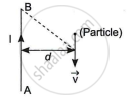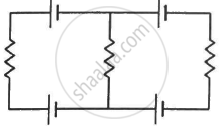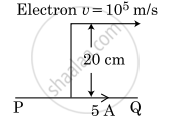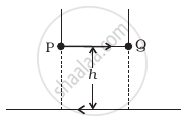Advertisements
Advertisements
Question
A long straight wire AB carries a current I. A particle (mass m and charge q) moves with a velocity `vec"v"`, parallel to the wire, at a distance d from it as shown in the figure. Obtain the expression for the force experienced by the particle and mention its directions.

Solution
Magnetic field induction at P due to current I in long straight wire AB is

`B = mu_0/(4pi) (2I)/d`
It acts perpendicular to the plane of the paper inward, represented by `hatn`.
Lorentz force acting on the particle at P can be given by
`vecF = q(vecv xx vecB) = e(vecv xx (mu_0. 2I)/(4pid)hatn)`
or `vecF = (mu_0Iev)/(2pid)(hatv xx hatn)`
∴ `F = (mu_0Iev)/(2pid)`
Acting in the plane of paper away from the wire.
RELATED QUESTIONS
Which of the following particles will experience maximum magnetic force (magnitude) when projected with the same velocity perpendicular to a magnetic field?
Each of the batteries shown in figure has an emf equal to 5 V. Show that the magnetic field B at the point P is zero for any set of values of the resistances.

A charged particle is in motion having initial velocity `vecv` when it enters into a region of uniform magnetic field perpendicular to `vecv`. Because of the magnetic force the kinetic energy of the particle will ______.
- If v is parallel to B, then path of particle is spiral.
- If v is perpendicular to B, then path of particle is a circle.
- If v has a component along B, then path of particle is helical.
- If v is along B, then path of particle is a circle.
What is the magnetic induction of the field at the point O in a current I carrying wire that has the shape shown in the figure? The radius of the curved part of the wire is R, the linear parts are assumed to be very long.

An infinitely long straight conductor carries a current of 5 A as shown. An electron is moving with a speed of 105 m/s parallel to the conductor. The perpendicular distance between the electron and the conductor is 20 cm at an instant. Calculate the magnitude of the force experienced by the electron at that instant.

A long straight wire carrying current of 25 A rests on a table as shown in figure. Another wire PQ of length 1 m, mass 2.5 g carries the same current but in the opposite direction. The wire PQ is free to slide up and down. To what height will PQ rise?

A beam of light travelling along X-axis is described by the electric field Ey = 900 sin ω(t - x/c). The ratio of electric force to magnetic force on a charge q moving along Y-axis with a speed of 3 × 107 ms-1 will be : [Given speed of light = 3 × 108 ms-1]
Distinguish between the forces experienced by a moving charge in a uniform electric field and in a uniform magnetic field. (Any two points)
Two long parallel current-carrying conductors are 0.4 m apart in air and carry currents 5 A and 10 A. Calculate the force per metre on each conductor, if the currents are (a) in the same direction and (b) in the opposite direction.
